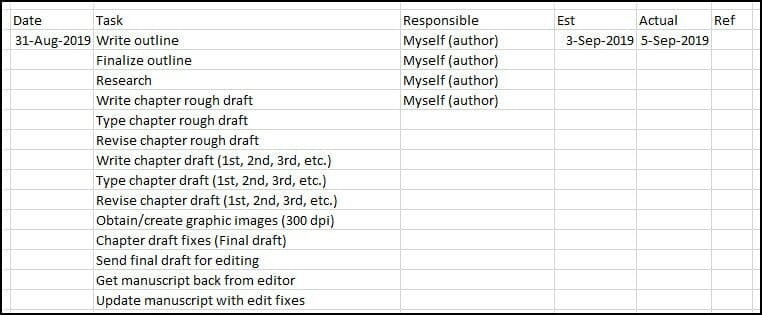Making time for writing can be extremely difficult – especially when all of your daily demands and responsibilities are fighting for your attention.
“I have a household to manage, kids to get to school, a 9-5 job, dinner to make…. How can I possibly fit time for writing in?”
Can you relate?
When writing in between life's responsibilities – family, work, kids, commuting – it can really feel like it's impossible to create a writing schedule that you can consistently stick to.
The key is to make time for writing in a way that fits into your current priorities and circumstances. ,
Is it really possible?
Yes! It’ll require effort and dedication, and it’s not always going to be easy, especially at first. But the more you stick to your writing schedule, the more naturally it’ll start to come.
If you're serious about writing a book, working according to a schedule can move you forward in leaps and bounds.
Sometimes it’s a matter of asking: How committed are you willing to be?
This post offers practical methods to create a writing schedule, but I'm not going to sugar-coat it: determination and discipline cannot be substituted, or circumvented. Nothing in this post demands extraordinary effort, but the core realities cannot be side-stepped. That's the way life works, and it's no different when it comes to becoming a published author.

A writing schedule that fits your lifestyle
You may very well have traveled the web looking for the golden nugget to create a writing schedule that has worked for others.
And I'd say it's not uncommon to have found some awesome suggestions, methods, and plans, but…
If a recommended schedule doesn't fit your personal circumstances, then it's worthless. Agree?
To have someone say you must write 1,000 words a day to be able to reach your target is preposterous if your lifestyle doesn’t allow for that.
For instance, let’s say you're a working mom. This means you have kids to take care of, dinner to prepare, plus your commuting time – and then there's still soccer practice, and all the unexpected day-to-day things that pop up. And you're still expected to write 1,000 words a day? Yeah, right.
But, if amongst your life commitments, you can make time to write 500 words a day, then that's a lofty, yet attainable quota.
That 500-word a day writing quota will then need to become a non-negotiable every single day. This means that no matter how busy you are, you need to make time for writing at least 500 words.
Then, on the days you can afford to make more time for writing or if you end up writing faster, you can increase that count to 750 words, and so on.
For all practical reasons, the best way to plan a writing schedule is to create it around your daily writing quota (amongst other things).
If you try and meet someone else's daily quota, it will usually cause stress and disappointment. That's a lose-lose situation.
Setting writing goals that are unrealistic is dangerous for your own productivity, and for your morale. It will have you chugging along on fumes, and will discredit any type of progress you have made towards your writing, simply because you didn’t reach that unrealistic goal.
That’s not a good place to operate for anyone, and it will be discouraging for you as you try to keep the discipline and momentum going.
From the words of the wise Alessandro Tinchini, “If you maintain your discipline, you will succeed.”
The Key to a Practical Writing Schedule
As a self-published author and experienced technical writer, I understand the importance of making time for writing.
What I've learned is that the key to an effective writing schedule is in it's practicality. It has to fit you.
Sometimes this means shifting priorities, delegating tasks, and compromising for time. And that's up to you to decide.
While I can't tell you what exactly a practical writing schedule looks like for you, since everyone has different needs, preferences, and lifestyles, I can help by sharing the constants in the equation.
And that’s why I want to share the six categories that can enable you to create a writing schedule that works for your personal lifestyle.
The 7 factors that contribute to an effective writing schedule are:
- Internal Momentum That Gets You Writing
- The External Factor to Make Time for Writing
- Interruptions That Derail Your Writing Efforts
- Planning Your Writing Schedule
- Organization Writing Ideas & Research
- Create a Routine Time for Writing
- Develop Healthy Writing Habits
Let's dive in to each of these factors as you make time for writing in your daily life and develop a writing schedule that works for you.
Internal Momentum That Gets You Writing
Think of long-distance athletes. They have to prepare mentally as well as physically. When the tiredness and pain set in, their mental training and stamina is what helps them push through and keep going.
Although the writing craft is not physical, you will encounter mental hurdles: self-doubt, fear, procrastination, and the list goes on.
When those nasties make their appearance, your mental stamina can get you through the misery when making time for writing seems impossible.
Strengthening your mental stamina starts with your “Why?”. Unquestionably, when you have a rock-solid reason why you want to write, you will be far better equipped to deal with hurdles that come your way.
“Even though I cannot influence your thinking and reasons for wanting to write and self-publish a book, I can say that if you have a superficial reason, it will be an uphill battle to get it done and you will almost certainly enjoy trivial success. Writing and self-publishing takes a lot of determination, perseverance, and patience. When your reason is backed by strong emotion, you have a powerful driving force.”
-Excerpt from my book
I'll be the first to admit that even though we have a deep-rooted reason for wanting to write, be that writing for a blog or writing children’s books, we can still face challenges.
As Zig Ziglar said, “People often say that motivation doesn't last. Well, neither does bathing – that's why we recommend it daily.” And to help you maintain your motivation, you have a range of tools available to stay motivated each day.
Use these tools to maintain internal motivation for your writing schedule:
# 1 – Positive Affirmations
These easy-to-use aids are not about hocus-pocus; they are actually very powerful tools that anyone can use.
In my forthcoming book, I give this advice: “Don't affirm bogus nonsense, like “I'm a NYT bestselling author. Instead use an affirmation like, “I choose to find it easy to write 1,000 words a day.”
Why do I refer to the first example as nonsense? Because that is something you don't have direct control over.
Being aware of what you do control, and don't control is so important in overcoming self-doubt as a writer and achieving success.
Affirmations are powerful tools you have at your disposal – they actually improve your overall mental state and well-being. These little power tools work with your subconscious, where there is untold power. Never underestimate the power of using affirmations.
Here is a video by legendary Bob Proctor on how powerful the subconscious mind is:
#2 – Visualization
This is something that I struggled with for many years. One of the tricks I came up with to help me visualize my goals is:
- I took a photo of myself sitting at the dining room (any table can work for you)
- I then created 3D e-covers of the books I was busy writing, and superimposed them in the photo (so it looks like I'm sitting at the table with the books in front of me)
- I now have a copy of that photo on my study wall, and inside my closet door – I look at the photo regularly, and take a minute to visualize myself as the author of these books already finished and published.
There are many other visualization ideas – find something that works for you.
In the book, Creative Visualization for Dummies, the following is offered: “When you practice something in your mind over and over again, and visualize it happening again and again, you begin to discover how to make it happen.”
#3 – Reticular Activating System (RAS)
The value of affirmations and visualization is unquestionable. There is actually scientific proof behind this.
“All of your future goals and dreams are not only a reflection of your subconscious thinking, they are also mediated by your Reticular Activating System (RAS). The RAS is the part of your brain that serves as a filter between your conscious mind and your subconscious mind. The RAS, which is located in the core of your brain stem, takes instructions from your conscious mind, and passes them on to your subconscious mind.”
Quote from the NLP Institute of California
Here is a short video by Mel Robbins on the RAS:
#4 – Meditation. I recently started meditating, and at the time of writing I can't verify how much it's benefiting me, but I have noticed that I've been a lot more productive in recent months.
Meditation for writers can be extremely effective, so give it a try if you haven’t yet!
The Super Important External Factor
Sticking to your writing schedule relies on the external factor, which is physically writing.
Once you’re internal strength gains momentum, you need to channel some of that positive energy to commit to actually writing.
The act of sitting down and writing is what I describe as the external factor. It can be tough for anyone, even seasoned writers, but once your internal strength is built, it will be easier to actually commit to the act.
We’ve all dropped the ball on the external factor when it comes to our writing schedule. The hard part about writing is actually writing.
Imagine this: You have the house all to yourself, which means you can get some writing done. You get your coffee ready, sit down at the table, and open up your laptop to your manuscript. You sit there waiting for the words to flow out of you, staring at the screen. Your mind trails away from the task at hand, and before you know it, you’ve wasted half an hour searching the web and – you guessed it – not writing.
It’s a scene many writers all know too well. And there’s really nothing to it: Your book will not write itself. You will actually need to write it. All of it!
And that’s where the external factor comes in. To make time for writing will require you to actually write.
Interruptions that Derail Your Writing Efforts
Interruptions (whether self-inflicted or from outside circumstances) are one of the biggest hurdles that can derail your writing schedule.
Naturally, we don't always have control over interruptions from outside.
For example, if your child has a problem, that takes priority, and you'll certainly not turn a blind eye and ignore your child.
Or, maybe you're managing a blog and get in a bind where you simply don't have the time to write articles for the month (in this case, you can always outsource your writing.)
But…
Self-inflicted interruptions are a different story.
“If you love life, don't waste time, for time is what life is made up of.”
-Bruce Lee

These interruptions can cause havoc with our schedule.
You do remember what I said at the start of this post about discipline? But, to be honest, discipline can work well with the big items. Looking at the items in the diagram above, the temptation can be great.
If you tend to waste productive writing time on social media (or other websites), a great tool to use for this is a blocking app.
There are some great apps (both free and paid) that do a great job to help with discipline:
- https://freedom.to/ (Mac, Windows, Android, or iOS)
- https://heyfocus.com/ (Focus is a Mac app that sits in your menu-bar)
- https://antisocial.80pct.com/ (Windows and Mac)
This may seem small, but I use RescueTime, and seeing what I've been busy with (or not) acts as an incentive to improve.
Planning Your Writing Schedule
“If you fail to plan, you are planning to fail.”
-Benjamin Franklin
This wisdom applies to your own planning as you figure out a writing schedule. Without planning, making time for writing can be a constant uphill battle.
This doesn't need to be a complex method, using special software. The humble spreadsheet works very well.
You may be tempted to focus only on the planning category of your writing schedule, but please don't ignore the other categories.
There are two legs to effective planning…
# 1 – Find your most productive time
One of the most valuable techniques I've found to create a writing schedule is to identify when you are most productive.
This can be done easily, with just a little awareness, and taking notes. Use a small notebook, or your phone, and then record the times and how easy (or difficult) it is to write. Do this for a week, and you'll find your most productive (and enjoyable) times to write.
#2 – Use the lowest common denominator
The other technique is to break up your writing project into the lowest common denominator (LCD) pieces. Sound familiar from math class? Not to worry, this doesn't have anything to do with math.

Although there is no hard and fast rule, try and make your LCD item in your writing schedule something that can be done in a day, or less. Naturally, that won't always be possible, but you can try – that way you'll be sure it is the smallest chunk that you can get done.
Looking at the spreadsheet above, you'll see that I have divided the Write outline and Finalize outline into two separate tasks. For example, this will probably apply when creating a writing schedule for a book. If you were writing a short piece, such as a blog post, then these two tasks can be condensed into one task and you would probably write and finalize your book outline in one day.
When you focus on the smallest piece of writing, you don't feel overwhelmed. And when this is combined with consistent writing, you will be amazed at what you get done in a week, a month, and especially in a year.
Check out the Word and Page Count Calculator to help break down your large writing goal into smaller chunks!
Plan in your calendar to be prepared as possible. You can prepare for things like vacation time, family visits, flu season, even if you don’t have the exact dates. When you do this, you will not be caught off-guard and your writing schedule won't be unexpectedly interrupted.
Organize Writing Ideas & Research
When an idea hits, or the excitement is running high, we tend to forget about filing those ideas and organizing them for retrieval later.
But, a disorganized working environment can be a time-sucking distraction.
I used to scribble notes in the car on the back of cash register slips (which is something I don't advise), and sometimes the snippets of paper would be thrown in my desk drawer. Luckily, most of the time, I would take a few minutes and capture the idea either on the computer, or in a spiral notebook.
Organize your source material and other research, and your work-in-progress drafts to make it easy to access whenever you need something.
Knowing where things are can save a tremendous amount of time.

Above is the folder structure I use for my books. Depending on the topic of the book, I could also have sub-folders in the Research folder. By doing this, I can find my material quickly, and no time is wasted.
# 1 – Create a Backup
In the technical writing field, a backup of material is mandatory. This is understandable, because it costs money if material is lost – very often, it’s the big bucks.
Although you probably won't be in the same situation (money wise), losing the drafts of a book's chapters, or a series of blog posts can be disastrous.
If you don't have a backup in place, set up one now.
Today, we are fortunate to have cloud storage, and there are free and paid options. Find a backup service that serves your needs.
Routine
Routine and consistency are so valuable in succeeding with a writing schedule and success with your writing projects. I can't emphasize this enough: if there are just two things you get right with your writing, make it these two.
When you set realistic goals, create your writing plan, do whatever you can to form a routine and make time for writing. You don't need to write large amounts every day, but when you do write on a consistent daily basis, you will make incredible progress.
#1 – Remind yourself to write

Set reminders in your routine to make time for writing. If possible, remind yourself at the same time every day.
One of the apps I use is the free ActionBuddy for Writers, where I receive an email reminder (set by myself) to write. I open the app from the email, and I start to write. Having the reminder pop up in my inbox is almost like having an accountability partner that reminds me to write.
#2 – Have a writing space
If at all possible, choose a specific place where you can focus and make it your writing space.
This is an important part of building a routine and habit; in other words when it's time to write, you physically get up and go to your writing place.
For me, it was writing at the dining room table, and later when the kids were out of the house, I had my study.
There will be times when things really become a struggle with writing; we're not machines and there will be times you won’t have any fuel to write.
When that happens, switch it up with writing. Instead, edit, find or create graphic images, do some research, or work on some marketing tasks. The change can be just what the doctor ordered.
When you follow a routine it leads to…
Healthy Writing Habits
When we form a habit with our writing, creating a writing schedule can be easier, and our productivity can go through the roof.
By creating healthy writing habits, you will consistently make time for writing. And when that happens, you’ll develop your own writing ritual.
No doubt you've read about the rituals of famous authors. Forming a ritual can have tremendous benefits to aiding the habit of writing.
My ritual was when I got home from the office, I would have tea and chat with my wife, then I'd go into my study (the dining room table in earlier years), and I would be in writing mode. The night before I had noted what I was going to write, and no matter what, as soon as I got into my study, it was open Word, and start writing what I had noted the night before.
The best way to create healthy writing habits is to work around your priorities. Squeeze in time for writing that centers around a habit that you can commit to every day.
“A dream written down with a date becomes a goal. A goal broken down into steps becomes a plan. A plan backed by action becomes reality.” – Unknown author
It Boils Down to Action
After all the planning is done, we need to take ACTION. I don't need to remind you that without action nothing will be accomplished.
When writing, don't waste time researching, rather use placeholders in your manuscript.

Above is an example of a placeholder I use in a book. When I'm done writing the draft, I can then return and do a search for my placeholders.
Then when the writing muse is not high, you can block out time to do your research. When it's writing time, write.
An accountability partner is extremely valuable to get us to take action. Build your network with fellow authors and writers who are in the same boat as you. If you don’t have any author friends, attend a writers conference and make some!
Procrastination can be a demon that destroys even the best attempt at creating a writing schedule.
The methods to create a writing schedule offered in this post are simple, not easy, but they can be done.
When the temptation raises its head, and you find yourself thinking about using (or misusing) hours that can be used to write, it's time to revisit your “why”.
Reminding yourself of the reasons you write can help you re-evaluate your priorities, and it can be just the thing to realign your mindset and focus back to your writing.
I wish you terrific, tremendous, and tumultuous success with your writing, and by committing to your practical writing schedule, you'll go far!
When do you make time for writing?


